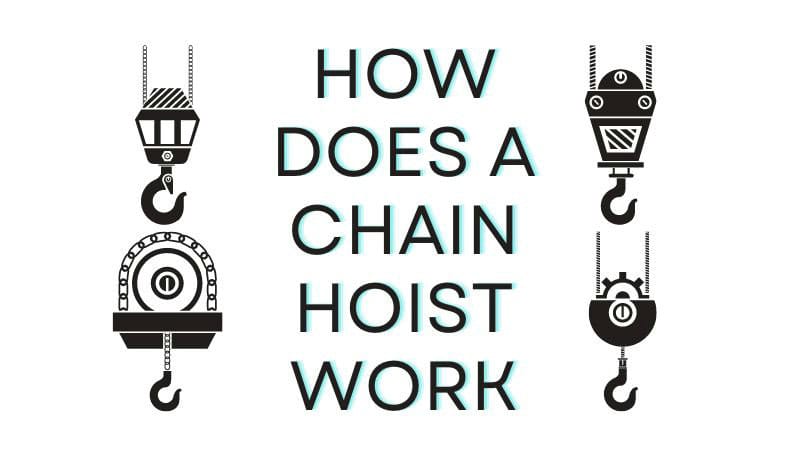
What is a Chain Hoist
Chain hoists are designed for lifting and materials handling with precision. They come in various types, which depend on the power supply and are comprised of several key components that contribute to their function.
The most common types of chain hoists include Manual Chain Hoists, Lever Chain Hoists, Electric Chain Hoists, and Pneumatic Hoists.
Lifting Mechanism of Different Types of Hoists

Manual Chain Hoists
Manual chain hoists, also known as hand chain hoists or chain blocks, use a simple gear and pulley system to lift loads manually.
- The operator pulls the chain on, which rotates a chain wheel connected to a gear reduction system.
- The gears multiply the force from the hand chain, allowing heavy loads to be lifted with minimal effort. The more gears (or falls of chain), the greater the mechanical advantage.
- As the gears turn, they collect the load chain on the load sheave, raising the bottom hook and attached load.
- A friction brake, typically a ratchet and pawl mechanism, automatically holds the load when the hand chain is released.
Lever Chain Hoists
Lever chain hoists use a similar gear and chain mechanism as hand chain hoists but are operated by a lever handle instead of a continuous hand chain.
- Pulling the lever handle up and down operates a ratchet and pawl system.
- The ratchet is connected to a gear reduction system, which multiplies the force from the lever.
- The gears drive the load sheave, collecting chain to raise the load hook, similar to a hand chain hoist.
- Directional levers allow the operator to switch between lifting, lowering, and neutral modes.
Electric Chain Hoists
Electric chain hoists use an electric motor to drive the lifting mechanism, eliminating manual effort.
- An electric motor turns a drive shaft connected to a gear reduction system.
- The gears drive the load sheave, which raises or lowers the load chain and hook, like manual hoists.
- An electromagnetic disc brake holds the load whenever the motor is stopped. This provides secure suspension of the load.
- The operator controls lifting and lowering using push button pendant switches.
Pneumatic Hoists
Pneumatic or air hoists use compressed air to power the lifting mechanism, making them suitable for hazardous environments.
- An air compressor supplies pressurized air to a vane motor inside the hoist.
- The vane motor drives a planetary gear reduction system.
- The gears rotate the load sheave, collecting or releasing the load chain to raise or lower the hook.
- A disc brake automatically holds the load when the air supply is stopped.
- The operator controls the hoist using a pendant with airflow levers.
How to Use a Chain Hoist Step by Step
Using a chain hoist involves precise control and understanding its basic operation. Y
Basic Operation
Manual Chain Hoists
- Check the Weight: Before using your hoist, determine the weight of the load to ensure it does not exceed the hoist’s capacity.
- Secure Anchor Point: Attach the hoist securely to a stable anchor point, such as a steel beam or trolley, that can support the weight.
Electric Chain Hoists and Lever Hoists
- Connect to Power: Ensure the hoist is properly connected to a power source (if electric) following manufacturer’s instructions.
- Familiarize with Controls: Locate the pendant or remote control for potential variable speed control.
Control and Precision
- Lift with Caution: Gently pull the hand chain or operate the control pendant to gradually lift the load. Avoid jerky movements which can destabilize the load.
- Monitor Carefully: Watch the load closely as it lifts, staying aware of any swinging or twisting.
How Much Weight Can a Chain Hoist Lift?

When selecting a chain hoist, weight capacity is a crucial factor. Depending on the model and design, chain hoists can lift loads starting from as little as 250 kilograms to heavy-duty hoists capable of moving up to 30-50 tons or more.
It’s essential to choose a hoist that meets your specific lifting requirements without risking overload.
- Light-Duty Hoists: Ideal for small shops, light hoists typically handle 250 kg to 5 tons.
- Mid-Range Hoists: For medium applications, these hoists can lift 5 tons to 10 tons.
- Heavy-Duty Hoists: Designed for industrial use, they can manage considerable weight, often ranging from 10 tons to 30 tons.
Never exceed the hoist’s maximum capacity, as it can jeopardize safety and functionality and always check that the anchor point and fasteners are robust enough to support the maximum load.
How to Select the Right Chain Hoist for My Work
Key Factors to Consider
- Lifting Chain Material: Look for durable chains that can withstand the wear and tear of regular use. Materials like steel are common for their tensile strength and durability.
- Gear Ratio: A higher gear ratio will be advantageous for lifting heavy loads as it requires less force to move heavier objects.
- Trolley: If you need to move your load along a beam, an integrated trolley, whether manual, electric, or air-powered, is essential.
- Rigging: Companion rigging equipment such as beam clamps or hooks should be adjustable and compatible with the hoist’s specifications.
- Environment: If you’re working in a hazardous or corrosive environment, look for spark-resistant or corrosion-resistant features to ensure longevity and safety.
- Standards Compliance: Check that the hoist meets relevant standards, like ASME B30, for your peace of mind and safety.
Additional Features
- Variable Speed Control: If you require precision, look for hoists with single, dual, or variable speed options that give you more control over the movement of your load.
- Ergonomic Controls: Opt for ergonomic control features that align with your operators’ comfort and safety, reducing fatigue.
- Remote Operation: In areas where obstacles are present or operator safety could be compromised, remote radio-operated chain hoists are a wise choice.
- Maintenance Features: Consider hoists that offer easy access to components for maintenance and those with safety features that alert you to potential overloading or other issues.
What Needs to be Considered When Buying a Chain Hoist

When you’re considering purchasing a chain hoist, it’s important to assess your specific needs and the environment where you will commonly use it.
- Weight Capacity: Think about the maximum load you’ll need to lift. Always choose a hoist with a capacity that exceeds your maximum load to ensure safety.
- Lifting Height: Determine the distance your loads need to be lifted. Be sure the chain length accommodates your height requirements.
- Environment: Consider the working environment. If your chain hoist will be exposed to harsh conditions, opt for a model designed to withstand such environments.
- Manual or Electric: Decide if a manual or electric hoist suits your situation best. Manual is good for precise control in areas without power, while electric can improve efficiency.
- Duty Cycle: How often will you use the hoist? For frequent lifting, a hoist with a high duty cycle is recommended to withstand the workload.
Frequently Asked Questions
Can you explain the lifting procedure involved with a chain block?
When using a chain block, you start by securing the device to a solid anchor point. You then position the load properly and pull on the hand chain. The force you apply turns the gears inside the hoist, which, in turn, lifts the heavy object attached to the other end of the chain.
How is an electric chain hoist different from a manual one?
Electric chain hoists differ from their manual counterparts in that they use electric power to automate the lifting process.
Rather than pulling a chain by hand, you can control the lift with a push-button, making it less labor-intensive and more suitable for frequent or heavier loads.
What are the safety considerations when using a chain hoist?
When operating a chain hoist, ensure that the anchor point can handle the load weight.
Always verify that the hoist and attachments are free of damage or wear.
Use the hoist directly above the load’s center of gravity to maintain balance and control.
How does a chain fall facilitate lifting heavy loads?
A chain fall is a section of your chain hoist that contains a series of interlocked loops. This design allows the chain to collapse and expand smoothly, creating the mechanical advantage necessary to lift heavy loads with relatively minimal effort.
What are the best practices for operating a chain hoist safely?
To operate a chain hoist safely, conduct regular inspections for any potential wear or damage.
Always follow the manufacturer’s guidelines for load capacity, and never exceed it.
Employ proper lifting techniques and ensure the load is secure before and during the lift.
